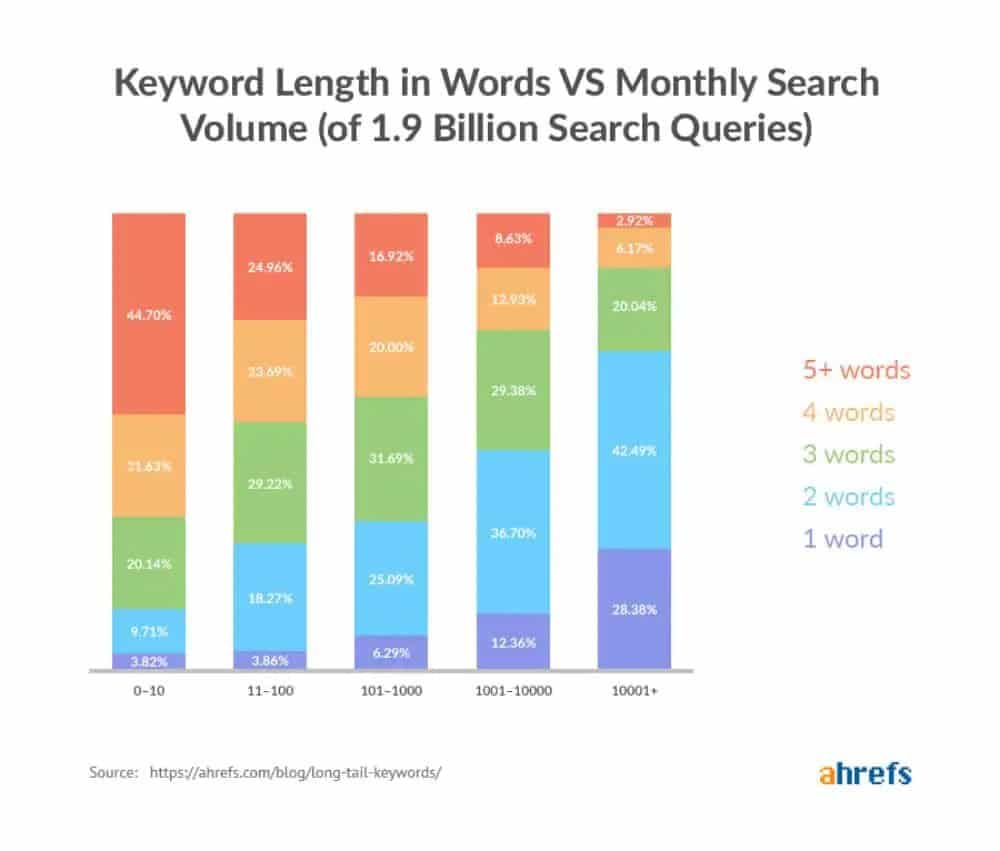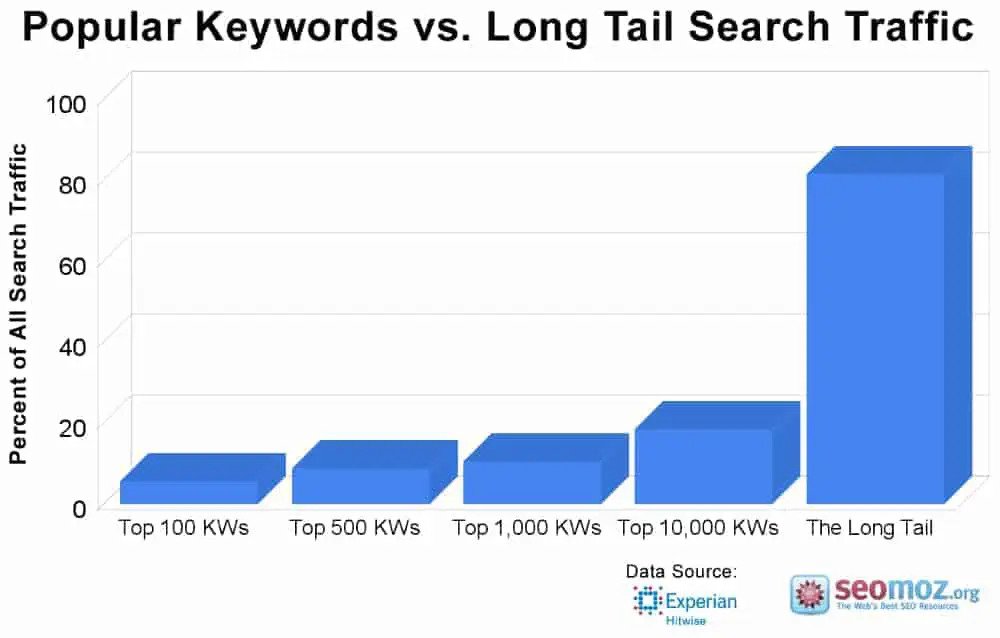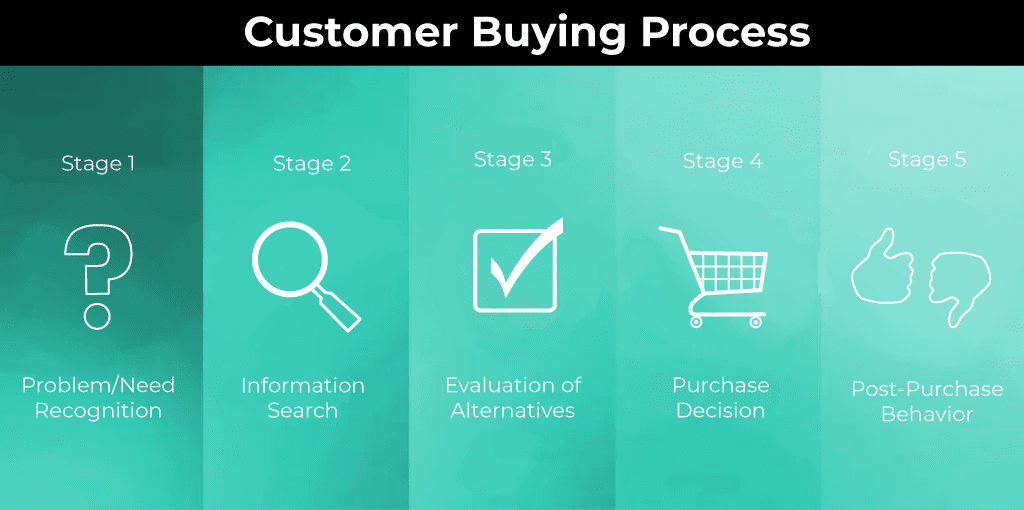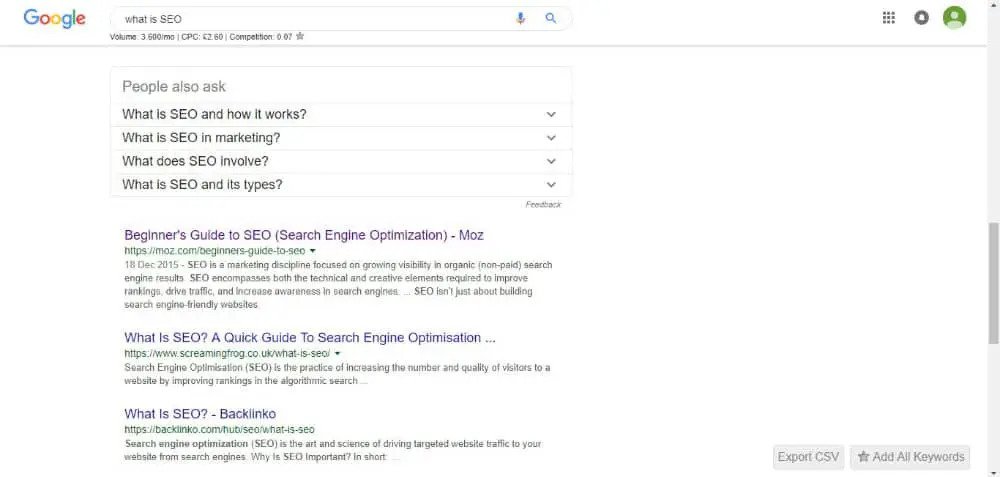Why You Need to Focus on Long Tail Keywords for Your SEO
SEO isn’t easy, any SEO professional will tell you that. Looking to outrank competing websites for those all-important keywords can at times seem like a real slog. That’s why anything which can help you along is a complete godsend. Long tail keywords fall comfortably within that exact category. In another article we cover the cost of SEO.
Ranking for long tail keywords is a great way for businesses to get themselves huge amounts of high converting, organic web traffic. As if that weren’t reason enough to focus on them, it’s also much easier to rank for long tail keywords. Smaller and newer businesses can find it almost impossible to break into the top SERP for really competitive keywords. Long tail keywords are much less competitive.
Building content around those keywords also ensures that searcher intent is well served by your website. That will keep both Google and the actual visitors to your site happy. Long tail keywords ought to be the foundation of your keyword strategy. That is if you want that strategy to be as efficient as possible.
If you’re still not convinced, we’re going to go into more depth about why long tail keywords are important later on. We’ll also offer some hints and tips for finding, ranking for and using those keywords. First, though, let’s get into what it is we mean by long tail keywords. If you don’t know that, how can you hope to get the most out of them?
Book a Consultation
What Are Long Tail Keywords?
Long tail keywords have a number of telling characteristics. They are keywords which have a low overall search volume. Meaning that there are comparatively few searches for them each month. That is because each long tail keyword is very specific.
They are not vague, wishy-washy searches. They’re searches carried out by people who know exactly what they’re looking for. Conversion rates for long tail keywords, as a result, are high. There is less distance to travel from a specific search to a potential purchase decision.
The specificity and low search volume of long tail keywords make them less competitive than others. That might put some people off when it comes to SEO, but it shouldn’t. That’s because the vast majority of web searches are for long tail keywords. It’s estimated that around 70% of all searches fall into the category.

When all that data is plotted onto a graph, it can be represented as shown above. The graph in question is often called the Search Demand Curve. It’s from this graph that long tail keywords get their name.
They are the keywords which comprise the curve’s ‘long tail’ which stretches across much of the x-axis. Keywords at the top of the curve, to the left, are called head keywords and those in between are body keywords. There is, however, a common misconception about why long tail keywords are labelled as such.
It’s Not About Word Length
The ‘long’ in long tail keywords is often mistakenly thought to refer to the length of the keyword itself. As we’ve already explained that’s not the case, but there is some factual basis to the mistake.
It often works out that long tail keywords are lengthier search terms. In many cases, they will be full questions entered into a search engine by a searcher. They may also be full and specific product names or other long stretches of text. That’s because it’s often by being longer, that a keyword becomes more specific.
In practice, shorter search terms can still be long tail keywords and longer ones can be head keywords. That’s shown clearly by the below graph based on data collected by Ahrefs:

What’s important to remember is that it is not word length which defines a long tail keyword. It is the keyword’s search volume, its specificity and how competitive it is.
Main Types of Long Tail Keywords
So far, so simple. Long tail keywords are search queries that are very specific, have low competition and equally low search volume. That’s the theory. As you may have guessed, things aren’t quite that straightforward in practice. Or at least, that’s not the full story.
Not all long tail keywords behave in exactly the same way from an SEO standpoint. Or rather, it’s perhaps better to say that they’re not all treated the same by Google and their algorithms. That’s because those algorithms have started to become extremely clever.
What that means for long tail keywords is that we need to split them into two main categories.
Supporting Long Tail Keywords
So-called ‘supporting long tail keywords’ have all of the general hallmarks of long tail keywords. They are specific search queries and have a low search volume. As such, you would expect them not to be particularly competitive to rank for. That’s where these keywords subvert expectations.
If you perform analytics on a supporting long tail keyword you will find that it’s much more competitive than it ought to be. If you enter the term into Google, you’ll find a SERP with lots of high authority pages that will be tough to outrank. What gives?
The answer to that is revealed by thinking a little more deeply about the keyword itself. Specifically, about whether it truly represents an individual topic or if it is actually asking a far more general question.
A keyword can be very specific and have low search volume as a result, whilst actually asking the same thing as a very competitive head keyword. ‘What are the best ways to lose weight?’ and ‘losing weight’ are two search terms that can be used to find the same answers.
Google’s algorithms are smart enough to recognise this. A SERP generated for the long tail keyword will include pages and sites that rank for the head keyword. Even if they don’t rank for the actual search term entered. That’s because Google knows they will still contain the information the searcher’s looking for.
These long tail keywords are search terms that support broader topics and their head keywords. That’s why they’ve been labelled ‘supporting keywords’. The characteristics of supporting long tail keywords are important to keep in mind when choosing the keywords to rank for. There’ll be more on that later.
Specific Topical Long Tail Keywords
Keywords that do relate to a specific, individual topic make up the other main category of long tail keywords. These are the stereotypical long tail keywords which we described when talking about the search demand curve.
They have a low search volume, are very specific and are not as competitive to rank for. SERP results for them will include pages that rank for the specific term and not for a parent topic. When it comes to trying to rank for long tail keywords, these are the ones which it makes sense to target.
It should be noted that not all long tail keywords fit neatly into either one of these two main categories. Some fall into a kind of grey area between them. Those which do, are keywords that represent an individual topic but still fit comfortably under the umbrella of a wider subject area.
As a SaaS SEO agency, for instance, we’re interested in the long tail keyword ‘SEO services in South West England’. That keyword will have low search volume and won’t be particularly competitive to rank for. It does sit clearly within the parent topic of SEO, however.
That means a SERP would likely include pages that rank for ‘SEO’. It may also include those that rank for related terms as well as for the specific long tail keyword. Those pages will have high page authority and great backlink profiles. They will also excel in other ranking factors for the parent topic of SEO. That will allow them to force their way onto the SERP for the long tail keyword, without targeting it.

Why Are Long Tail Keywords Important?
Now that you know what long tail keywords are, let’s talk about what makes them important. As we’ve already mentioned, they make up around 70% of all web searches. Ignoring all of those searches would mean ignoring a huge amount of possible organic web traffic.
That alone would be enough to make long tail keywords important. There are a host of other factors, however, that add to the critical nature of the keywords for SEO purposes. We’ve outlined these below. Hopefully, they’ll be enough to prove that long tail keywords should form the basis of your SEO strategy.
Easier to Rank
Each long tail keyword represents a very specific search term. That means that each one has a very low search volume. So far, this may seem like a problem, not an opportunity. The opportunity comes from what that means for the competitiveness of the keywords.
Each long tail keyword will have little competition to rank for it. That means you can vault up the SERPs for each keyword far more easily. Your content won’t have to be quite as good. You won’t need quite as many backlinks. All in all, it will take less time, expense and effort to get a top ranking for long tail keywords.
High Conversion
SEO is not only about getting searchers to find your website or pages. It’s not even only about increasing your site’s organic traffic. It’s also about improving your sales or getting more people to sign up to your services. How well any web traffic converts into sales is something that needs consideration.

Web searchers are potential customers. Customers can all be placed somewhere along the customer buying process. That is the journey any customer takes towards making a purchase. It extends from the initial recognition of a problem or a need, all the way to them buying something. Customers search differently depending on where they are along that journey.
Long tail keywords are used by searchers who are close to a purchase decision. They know what it is they want, so can be very specific with their search query. Traffic from long tail keywords, as a result, has a high conversion rate. There is less distance for the searcher to travel from their search to their decision to buy.
Search Intent
There’s a reason why long tail keywords account for around 70% of all web searches. They are how ordinary people search the web. If you want to know the answer to a question, you’ll type that question into Google. You won’t search for a topic related to it and then comb through the results yourself.
That means that content built around long tail keywords excels in terms of user intent. As long as it is focussed on a keyword that searchers actually use. The content will be useful to readers who find it and will directly answer their needs. These are factors which Google view as being of prime importance. Such content will put you in the search engine’s good books in short order.
Help With Head Keywords
The thrust of this article is that it’s crucial to focus on long tail keywords. That doesn’t mean that you shouldn’t also try to rank for the more popular head keywords. Those keywords have much higher search volume but are also far more competitive. That means it takes a lot more time and effort to rank well for them.
Ranking for related long tail keywords can help the process along. Google is able to assess the context and overarching topic of your content. Ranking well for long tail keywords related to your overall field will help you to rank for the field’s more competitive head keywords in the long run.
Drive Content Marketing Strategy
Good SEO takes time and often requires quite a large investment of capital. One reason for that is because you need to have a long-term, high-quality content marketing strategy. Your site must continually produce new, original and useful content for users. That means that you need a good supply of different topics and subjects for the content to focus on. Long tail keywords can double as inspiration for those topics.
A specific long tail keyword is a subject which real searchers want to find out about. Blog posts or articles focused on those keywords will answer their desires. They will also be demonstrably different from one another. That avoids duplicate content and helps to keep Google happy.
How to Find Long Tail Keywords
The importance of long tail keywords should by now be abundantly apparent. That means you’ll naturally want to know how you can find the long tail keywords that’ll boost your SEO efforts. There’s no better time to jump into that subject than right now.
The key to finding useful long tail keywords is the process of keyword research. We explain that process in depth here, but if you’ve not got time to read our guide let’s have a brief refresher.
Keyword Research Refresher
Keyword research should start with the searchers and not the searches. You need to put yourself in the shoes of your prospective customers. You can do that by building a customer persona. That’s a profile of your target customers, detailing their age, gender, income and other crucial characteristics.
You can then use the customer persona to develop niche topics that you think your target customers will be interested in. Looking at forums or even Wikipedia pages related to your field can also help to develop these topics. It is from those niche topics that you can then generate potential long tail keywords.
Hints for Finding Long Tail Keywords
There are many different ways to generate long tail keywords related to your niche topics. With a good understanding of your customer persona, you should be able to come up with plenty off the top of your head. Once you’ve exhausted your own imagination, there are lots of other places you can also look.
Heading to Google is a good start. If you begin to type in a topic or keyword, Google’s auto-complete feature can give you a host of other long tail keyword possibilities. Once you’ve hit enter on a search, there are two other places to look for suggestions.

If you’ve searched for a question, scrolling part way down the SERP will bring you to the ‘People also ask’ widget. That will show you a number of questions related to the one you searched for. Some or all of them might be worthwhile long tail keywords.

Head all the way down to the bottom of the page and you’ll find the ‘Searches related to’ feature. That is yet another list of questions, phrases and search queries similar and related to your original request. In other words, they’re a selection of potential long tail keywords.
Analytical tools and processes can help you generate even more keywords to work with. There are loads of free to use keyword research tools that you can choose from. Entering a phrase or subject into a tool like Moz’s Keyword Explorer can produce a whole list of other possible alternatives.
Competitor analysis is something else that can help you to find long tail keywords. Analysing your competitor’s pages will reveal which keywords – of any and every type – they are ranking for. Any long tail keywords that they rank for and you don’t are ones which you can look to target.
Using & Ranking For Long Tail Keywords
Following the above hints and tips will get you to a point where you have a lovely long list of long tail keywords. What you’ll want to do then is to start using those keywords and begin ranking well for them on SERPS. Where long tail keywords prove most useful is in content marketing. It is a good idea to make long tail keywords the focus of your content.
That will make the content useful to users who search for the term in question and is sure to impress Google. It will also make it easier to keep articles and posts original and to avoid duplicating content. When you do build a content marketing strategy around long tail keywords it’s important to remember the two main types of those keywords.
Content focusing on supporting keywords will help you rank for higher volume head keywords in the long term. However, they will be more difficult to rank for than other long tail keywords. This is simply due to the fact that high authority pages will be ranking for the supporting long tail keyword’s parent topic.
Pages or posts focusing on specific topical long tail keywords will rank more readily. There will be less traffic related to each keyword, but it will be traffic with a high conversion rate. The best content marketing strategy will include content focused on a combination of the two types of long tail keywords.
What’s most important about all of the content is that it does answer the intent of a searcher. It must actually address the question or query that they’ve searched for. This is far more important than following keyword-centric guidelines. The natural use of keywords in useful content is more useful than high keyword density.
The Bottom Line; Focusing on Long Tail Keywords
Long tail keywords are low search volume, low competition keywords. They make up around 70% of all web searches and deliver high converting organic traffic to your website. Their name comes from the position they occupy on the search demand curve and has nothing to do with their word length.
All of their advantages mean they should form the foundation of your content marketing strategy. They are easier to rank for than head keywords and have higher conversion rates. They also help to provide inspiration for the topics of your content and keep that content focused on user intent.
You shouldn’t ignore higher volume head keywords. The best SEO strategies, however, will focus on long tail keywords and getting the most out of them.


